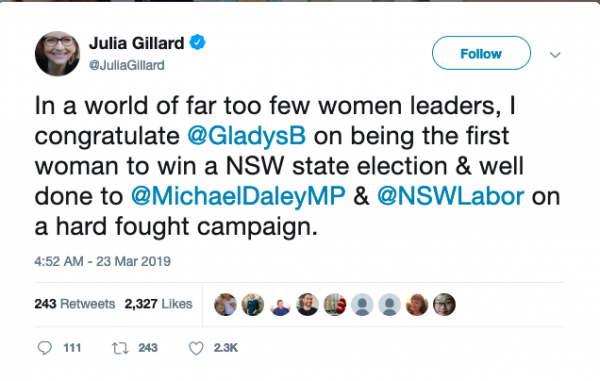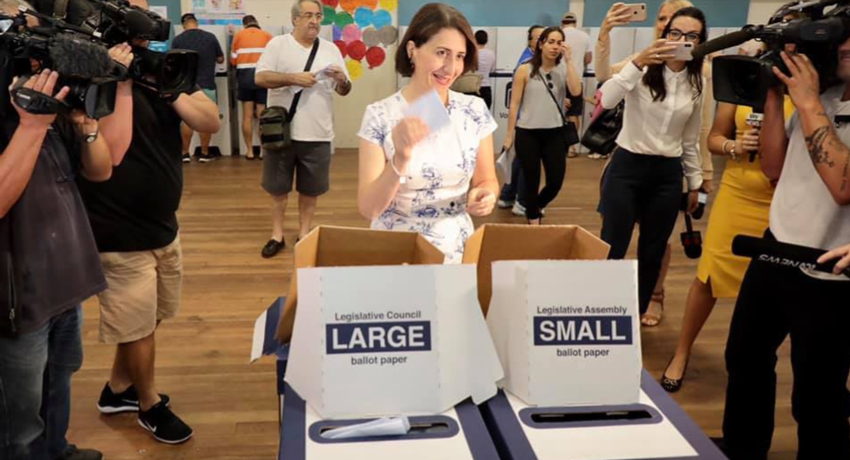‘Gladys Berejiklian has succeeded in becoming New South Wales’ first elected female Premier since non-indigenous women in the state received the vote in 1902. Regardless of whether Berejiklian actively represents women’s issues, her electoral win was a significant feat, breaking through the glass ceiling.
Disappointingly, the response to Premier Berejiklian’s election demonstrates that in Australia, the media is still a long way off from breaking gender stereotypes in political coverage.
Following her weekend victory, Monday’s press recycled a number of tropes that have historically been used to pigeon-hole women.
Newscorp’s Daily Telegraph went with the age-old stereotype of women’s role as the housekeepers of the public realm, with the headline ‘Gladys Set To Clean Up’ and noting in its opening paragraph that the NSW Parliament “will be cleaned up with higher standards expected of politicians under sweeping reforms to NSW’s notorious bear pit set to be the first offering from Premier Gladys Berejiklian to the crossbench”.

Is this really how we want to portray professional women – as housekeepers who will come and ‘clean up’? Image: Shutterstock
Tabloid press responses such as this might be expected, but more surprising given it prides itself on its support of women in leadership, was the front-page story run by the Australian Financial Review with the headline ‘NSW’s top prefect shows how politics is done‘.
In his article, journalist Aaron Patrick suggested it was surprising that Premier Berejiklian was reinstated given: “She lacks a spouse and children. She’s not photogenic. She had no impressive professional or personal achievements before entering politics. She shows little interest in intellectual pursuits, sport or culture. She’s Armenian.”
And, as if her choice of clothing was relevant, Patrick makes an observation about how the Premier’s “simple patterned dresses and low-heeled shoes” protected her from criticism.
This kind of media coverage reflects what Blair Williams, PhD candidate at the Australian National University, has found through her comparative research examining media reportage of women prime ministers. Through this research, she has identified five ‘gendered tropes’ that are consistently used by the print media, crossing time and countries:
- A femininity trope: focussing on their gender (female/woman, etc.) and portraying them in stereotypically feminine ways (warm, smiling, calm, housewife, headmistress, etc.);
- An appearance trope: an emphasis on appearance, such as their hair, bodies and fashion;
- A family trope: a preoccupation with their marital status and family relations, with a particular emphasis on whether they are married and have children
- A first name trope: rather than use their titles and surname as is the case with men, serving to delegitimise them
- A Thatcher trope: measuring the performance of the female politician against the performance of the UK’s first female Prime Minister.
These tropes refer to the use of significant themes, based on socially ingrained gender stereotypes and gender norms, that reinforce the existing gender order in which male politicians are treated as neutral and normalised and female politicians are seen as atypical and trivialised.
Journalists aren’t necessarily conscious of their use of the gender tropes; rather they reflect institutionalised gender biases. They reveal how society views women, especially women in power.
It is important to have more women in elected politics, and especially holding executive positions, as it further normalises women in politics and ensures a more representative government. The argument has been well made that the more we become familiar with women in political and other leadership positions, the less they will be cursed by gender stereotypes, and the greater the chances of achieving cultural change and gender equality.
Research has shown that the higher the level of gendered media coverage, the lower the number of women political candidates
Research has shown that the higher the level of gendered media coverage, the lower the number of women political candidates. It can even impact on ordinary women’s career and political aspirations, decrease their self-esteem and diminish their sense of self-efficacy.
Using the framework Williams has developed provides a lens for easy identification of whether news articles are gendered in their coverage of women in politics.
Aside from comments on her outfits and family, Berejiklian was also likened to a ‘head prefect’ in the headline. Comparing her leadership to that of a school child is infantilising and trivialising of her role as Premier, and also brings with it a connotation of her being a bossy head girl, and a swot. This was reinforced by the AFR article’s claim she had no outside interests.
Additionally, her leadership style was described through stereotypically feminine language, identifying her ‘maternal’ approach, her role as a ‘cleaner’ and as someone who expresses ‘gratitude’ and ‘humility’.

Male politicians and political leaders rarely experience this kind of gendered coverage. Berejiklian’s predecessor, Mike Baird, who also ascended to the role through the resignation of a sitting Premier to win the election in 2015, experienced starkly different treatment.
A comparison of the two Australian Financial Review articles written by the same journalist from the Monday after the elections provides a snapshot of different reportage of male and female leaders.
In contrast to Berejiklian’s piece, Baird’s article ran under the neutral headline ‘Coalition Premier Mike Baird wins NSW election‘.
While Baird was noted as saying he “loved the state”, there was no reference to him being nurturing in his approach. There was no reference to Baird’s family, no mention of how he would juggle his life as a father of three children or keep his marriage on track while holding such a high-profile job. His gender was not referred to, nor was reference made to his appearance. Rather, he was discussed in an impartial manner with the focus lying on his electoral success and policy agenda, rather than his personal attributes and relationships.
Due to his gender and background, Baird was just another in a long line of similar leaders, and as such, considered the political norm. By contrast, Berejiklian was treated as exceptional
Due to his gender and background, Baird was just another in a long line of similar leaders, and as such, considered the political norm. By contrast, Berejiklian was treated as exceptional.
While it is one thing to celebrate that first elected female Premier in NSW, it is quite another to do so in a way that trivialises and reinforces the gender stereotypes that make this such a difficult position to achieve in the first place.
But there is an easy solution: when journalists write articles about women leaders, and editors approve the copy, they need to imagine how the same headlines and article would read if the subject was a man. If it’s jarring or sounds different to how male leaders are described, it needs a re-write to ensure it doesn’t reinforce gender stereotypes that detract from women’s access to political power.





